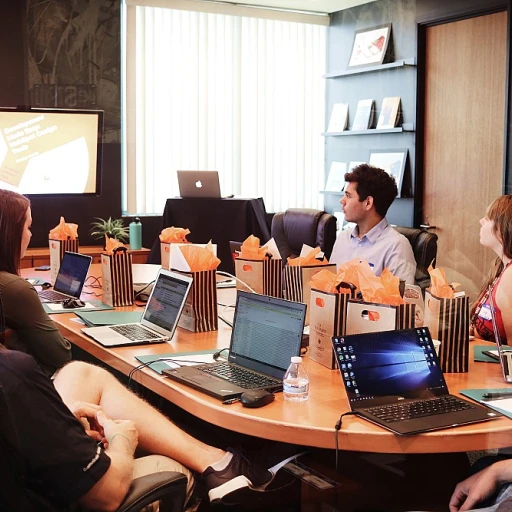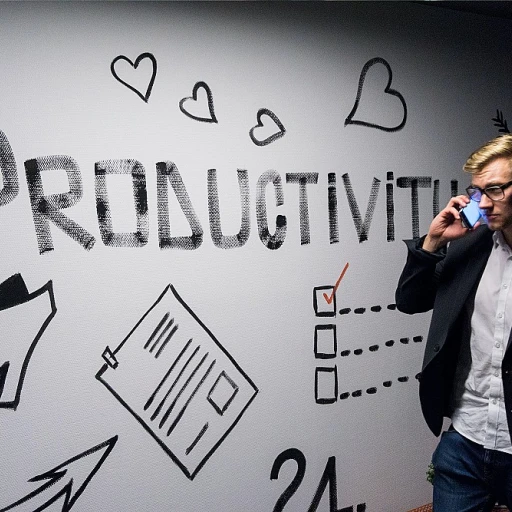Understanding Collective Learning in Onboarding
Exploring the Roots and Necessity of Learning Collectively
The concept of collective learning is not just a recent phenomenon; it has deep roots in human history and has played a pivotal role in the evolution of our species. Thousands of years ago, early homo sapiens relied heavily on the ability to share knowledge through language and social interactions. This human capacity for collective learning has enabled the advancement of culture and the development of problem-solving tools and ideas. As social beings, our ancestors used language as a vehicle to pass down instructions and skills, from tool-making to hunting strategies, which contributed significantly to our survival and progress.
Modern workplaces can harness this ancient advantage of social learning by creating an environment that fosters knowledge sharing and collaboration. Incorporating collective learning in onboarding processes can accelerate the integration of new hires, offering them a glimpse into the company's longstanding learning culture. It helps in creating a community where knowledge is not confined to individual silos but is accessible to all, ensuring that the workforce evolves collectively, much like how humans have evolved over time.
An effective onboarding program leverages collective learning by embedding learning development strategies that encourage both the new and existing employees to engage in shared knowledge exercises. This environment not only aligns with the organization’s goals but also promotes a sense of belonging and self-efficacy among new entrants, which is crucial for their long-term success.
Moreover, the practice of collective learning within the corporate setting serves multiple benefits. It leads to diverse problem-solving approaches and encourages a learning culture that adapts and evolves. With the right strategies, companies can replicate the collaborative instincts of early humans to create dynamic and resilient teams.
Understanding the link between our historical reliance on shared learning and its present-day applications can offer valuable insights. It guides us in shaping strategies for successfully integrating new hires while sustaining a thriving, collaborative environment. For practical tips on inspiring this shared responsibility and enhancing engagement, explore affordable ways to boost employee engagement.
Key Elements of Effective Onboarding Programs
Crafting Meaningful Onboarding Experiences
In today's corporate landscape, understanding the power of collective learning is crucial for designing impactful onboarding programs. As human beings, our capacity for social learning has allowed us to share knowledge and ideas, supporting our evolution as a species. Blending this historical prowess with modern tools is key to developing a robust onboarding strategy.
To create an effective onboarding program, it’s important to recognize the significance of an engaging learning process. Leveraging a learning management system (LMS) can facilitate this by integrating various learning modes. Such an approach acknowledges the rich history of knowledge sharing that dates back thousands of years, encouraging participation in a culture of collective learning.
Incorporating Social Learning
Central to an effective onboarding program is fostering an environment where new hires can readily share knowledge and learn from their peers. This method echoes language collective practices of early human history, which highlight the importance of social dynamics in learning and evolution. Encouraging interaction among new recruits taps into their innate problem-solving skills, enhancing the group’s overall development.
Evolving with Time
As corporate learning evolves, it’s essential to build programs that adapt to the changing landscape. By reflecting on history and cultural changes, onboarding efforts can remain relevant and meaningful. This long-term perspective accommodates shifting dynamics and helps maintain a competitive edge.
Promoting a Learning Culture
Implementing an onboarding program that encourages a culture of continuous learning ensures that knowledge sharing remains integral to the organization's ethos. This environment supports collective ambitions and fosters personal growth, benefiting both individuals and teams.
By prioritizing these elements, organizations can craft onboarding experiences that not only integrate new hires but also enhance team dynamics through
group coaching programs. This holistic approach is instrumental in building a cohesive and developmental workforce.
Challenges in Implementing Collective Learning
Overcoming Hurdles in Implementing Collective Learning
Implementing collective learning in onboarding is not without its challenges. As organizations aim to foster a learning culture, they must first address the various hurdles that can impede the process. Primarily, the evolution of how people learn and share knowledge has transformed since homo sapiens first engaged in social learning years ago. This evolution has fundamentally changed modern onboarding practices.
One significant challenge is synchronizing learning preferences within a diverse team. Each human being brings unique experiences and expectations, shaped by personal history and culture. Creating an inclusive learning environment requires accommodating these differences, a task that can be daunting for any organization. It's crucial to capitalize on the social nature of learning, where people naturally share information and ideas through language and social interaction.
Another problem is ensuring the right tools and platforms support collective learning effectively. While contemporary LMS (Learning Management Systems) offer advanced features, not all organizations leverage them effectively to facilitate interactive and collaborative learning processes. Often, these systems are underutilized, leading to a lack of engagement and low knowledge retention.
Additionally, fostering a robust collective learning culture means overcoming resistance to change. Some might see it as a disruption to the traditional onboarding routine. Such change resistance calls for strategic communication and gradual implementation to ensure team buy-in.
Addressing these challenges requires a blend of strategy, technology, and cultural shifts within the organization. The ability to adapt and evolve in line with human evolution and learning history is essential. This could involve investing in technology that supports a more social learning environment or focusing on building a comprehensive problem-solving training approach in onboarding.
Benefits of Collective Learning for New Hires
The Power of Knowledge Sharing and Social Learning
The integration of collective learning into onboarding programs significantly enriches the experience for new hires, embedding them into a community that thrives on shared knowledge. This practice is deeply rooted in human evolution and the history of homo sapiens. As a species, our ability to communicate and transmit ideas through language has allowed us to survive and adapt to the ever-changing world around us.
By participating in collective learning, new employees can tap into the extensive experience and insight of their peers, creating a dynamic learning environment. This social learning not only enhances individual skills but also fosters a learning culture where team members feel empowered to share knowledge and collaborate on problem-solving challenges.
For many years, human beings have relied on the collective evolution of ideas and solutions to navigate complex issues. In today's corporate learning environments, tools like learning management systems (LMS) enable a seamless exchange of knowledge, effectively breaking geographical barriers and connecting individuals in a shared quest for growth.
Cultural Exchange and Strengthened Team Dynamics
One of the compelling advantages of collective learning is the cultural exchange it promotes within teams. Bringing together people from diverse backgrounds and experiences enhances the overall learning development of the group. This melange of cultures and ideas enriches the onboarding experience, creating a fertile ground for innovation and creative problem-solving.
Through a shared learning process, new hires not only assimilate into the company culture more effectively but also contribute their unique perspectives. This exchange fosters an inclusive environment where everyone has the capacity to contribute and learn from one another. As a result, team dynamics are strengthened, building a cohesive unit capable of even greater achievements.
Enduring Benefits of a Collective Approach
Implementing collective learning in onboarding brings enduring benefits that extend far beyond the initial integration period. New hires become part of a knowledge sharing ecosystem where they continue to learn and teach throughout their tenure. Over time, this perpetuates a cycle of continual improvement and innovation within the organization.
Ultimately, the capacity for collective learning becomes a powerful tool in retaining and developing talent, making it a strategic priority for businesses seeking to enhance their workforce's overall effectiveness. In harnessing these benefits, organizations establish themselves as nurturing environments where individuals are encouraged to evolve, just as our ancestors did thousands of years ago.
Role of Technology in Facilitating Collective Learning
Leveraging Technology for Enhanced Collective Learning
In today's rapidly evolving corporate landscape, technology has become a pivotal partner in shaping and enhancing collective learning experiences. With years of technological advancement under our belt, we now stand at the crossroads of leveraging innovative tech tools to facilitate both individual and shared learning processes within onboarding programs.
One of the key elements of successful collective learning is the ability to share knowledge seamlessly. Learning Management Systems (LMS) are a cornerstone of modern onboarding programs, offering an integrated platform where new hires can access a wealth of resources—ranging from corporate culture insights to comprehensive knowledge-sharing modules. These systems harness the power of social learning, fostering an environment where communication and idea exchange flow effortlessly between team members.
Moreover, the evolution of human beings over centuries has been marked by a persistent capacity for problem-solving and adapting to new environments. Technology serves as a modern reflection of this evolutionary trait, equipping organizations with the tools needed to streamline the learning process and improve new employee integration. By tapping into the social aspect of learning, technology deepens engagement, allowing for a richer, more immersive onboarding experience.
Language, a distinguishing characteristic of homo sapiens, plays a critical role in the collective learning framework. Digital platforms offer multilingual support, ensuring that language barriers don't hinder learning opportunities. This synchronous and asynchronous learning capacity takes us back to the essence of what human history has long demonstrated: collaboration and knowledge sharing are central to survival and success.
History shows that the species capable of sharing ideas and developing a shared understanding across cultures and expanses are the ones that thrive. Corporate onboarding programs that integrate technology to facilitate this evolutionary advantage not only enhance immediate learning outcomes but contribute to long-term talent development and employee satisfaction. In this age of digital revolution, the challenge lies in effectively utilizing these tools to create an enriching learning culture that aligns with both corporate goals and individual aspirations.
Measuring the Impact of Collective Learning
Evaluating the Influence of Collective Learning
To gauge the success of collective learning in onboarding processes, measuring its impact is key. It is here that the learning management system, often referred to as LMS, plays a pivotal role. These systems not only streamline the learning process but also serve as an indispensable tool for tracking progress and determining whether the necessary social learning outcomes are achieved.
In the history of learning, human beings have always thrived by sharing knowledge and ideas, a practice deeply rooted in human evolution. This species-specific ability to engage in collective learning has been fundamental, from early Homo sapiens sharing insights around a campfire years ago to today's complex corporate environments.
The collective aspect of learning is also deeply tied to the capacity for language, allowing insights and knowledge to be shared effectively. For years, onboarding programs have evolved to incorporate this evolution collective using digital tools and platforms, fostering a culture where employees feel comfortable sharing their learnings and experiences.
Evaluating the impact of such programs often involves looking at the problem-solving capabilities that new hires develop. The capacity to solve problems efficiently can be a direct indicator of how well collective learning has been implemented. Furthermore, it is essential to examine how well these new hires adapt to the culture and knowledge-sharing practices within the organization. This reflection on the onboarding process helps identify any gaps in the learning culture and ensures continuous improvement.
By systematically measuring outcomes, companies can refine their onboarding programs. This improvement perpetuates a cycle of learning development, ensuring that the onboarding experience remains a dynamic and evolving journey respecting the cookie policy of continuous corporate learning.













